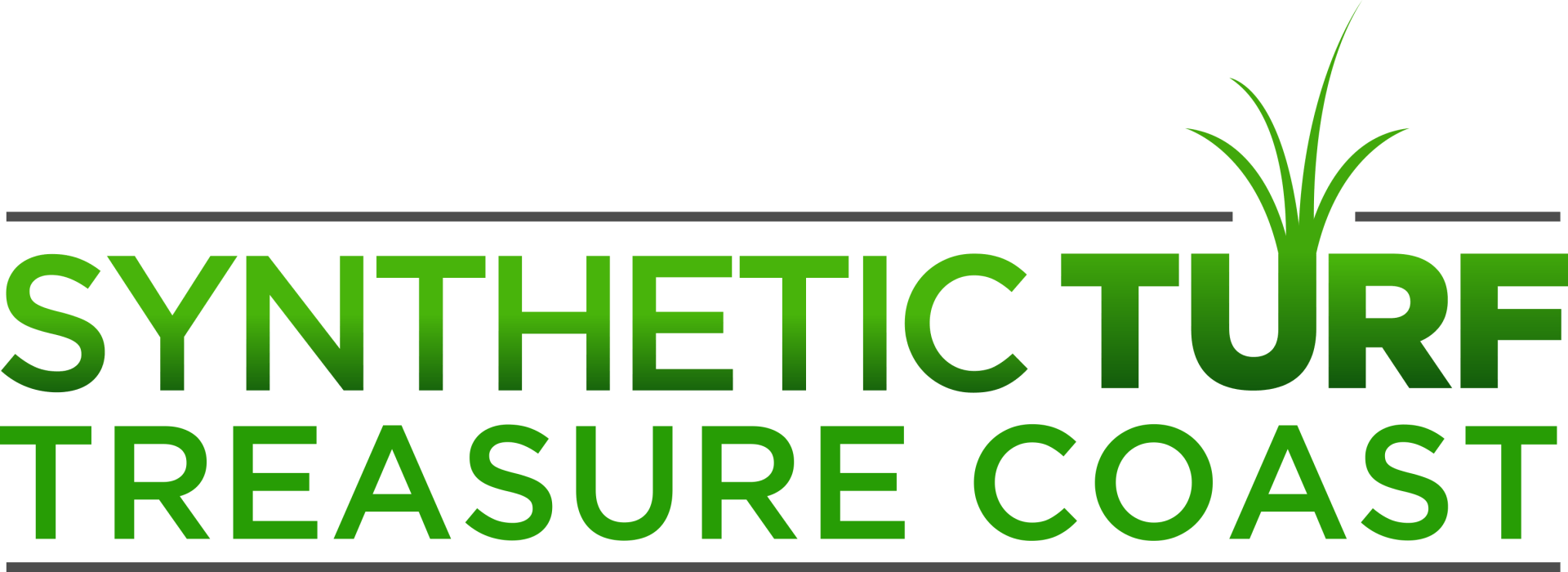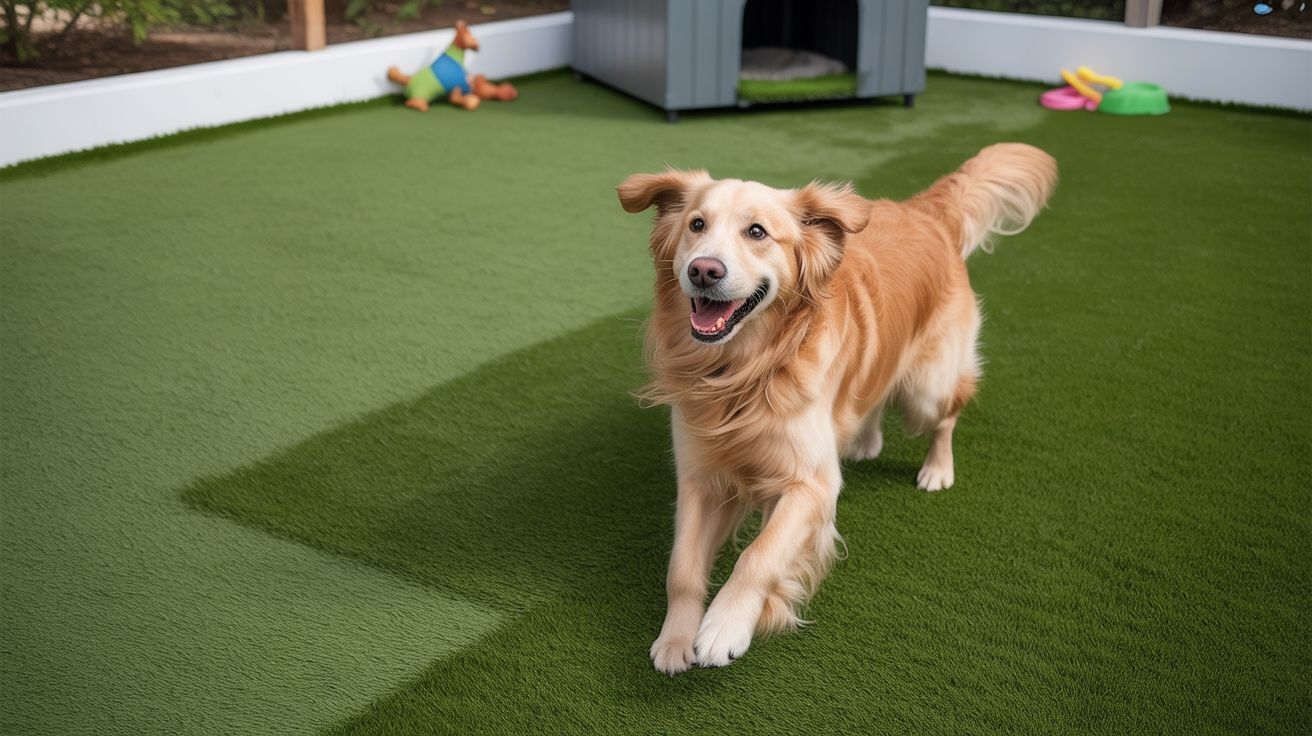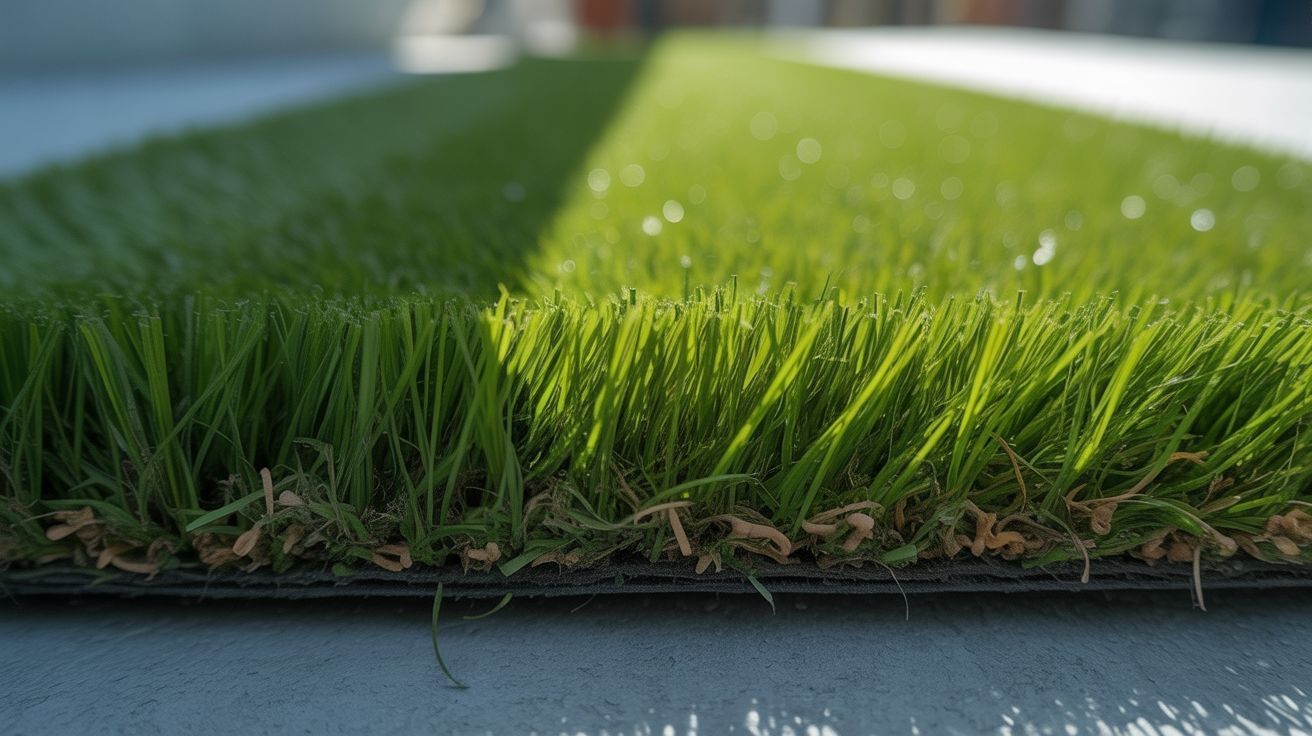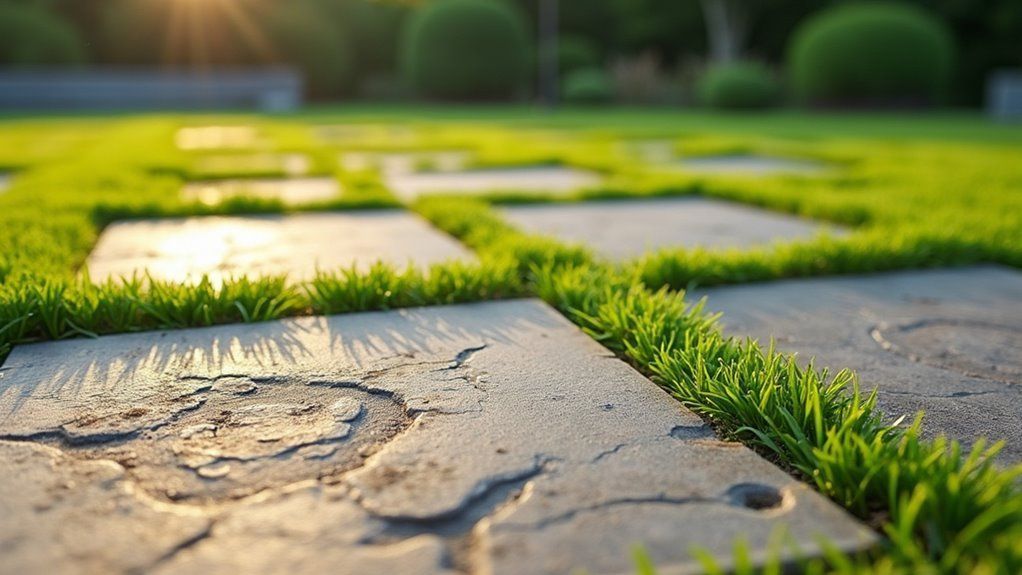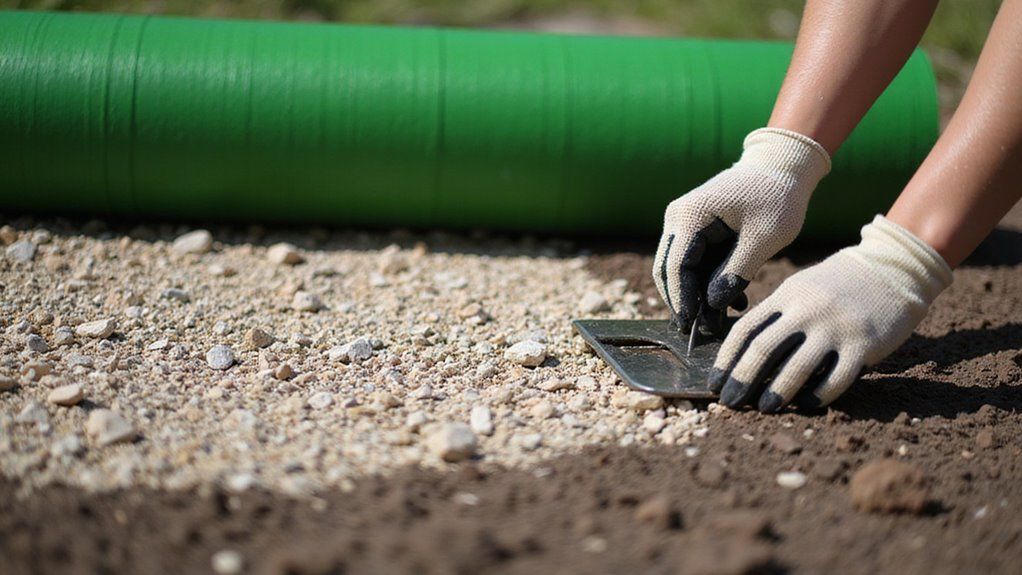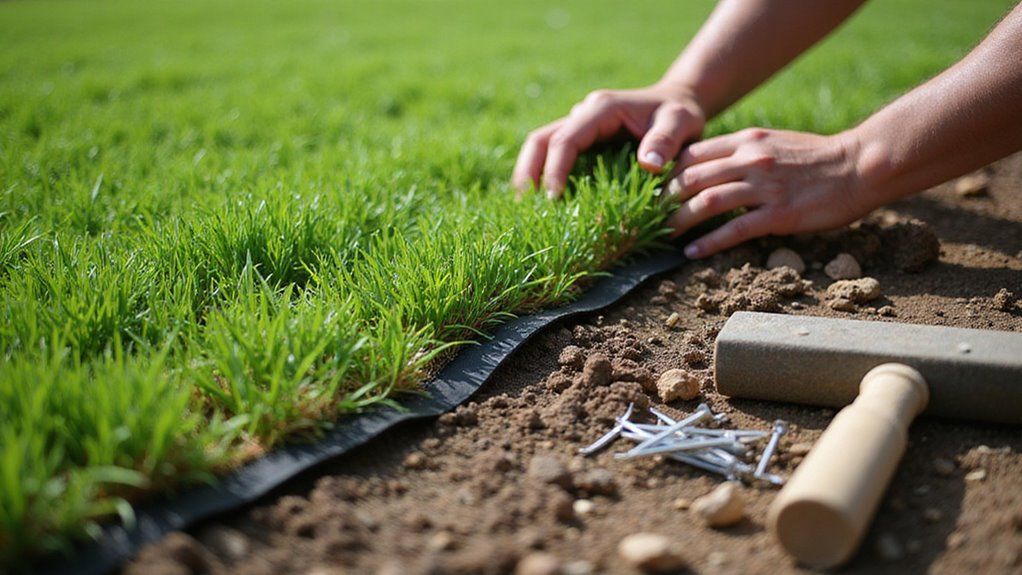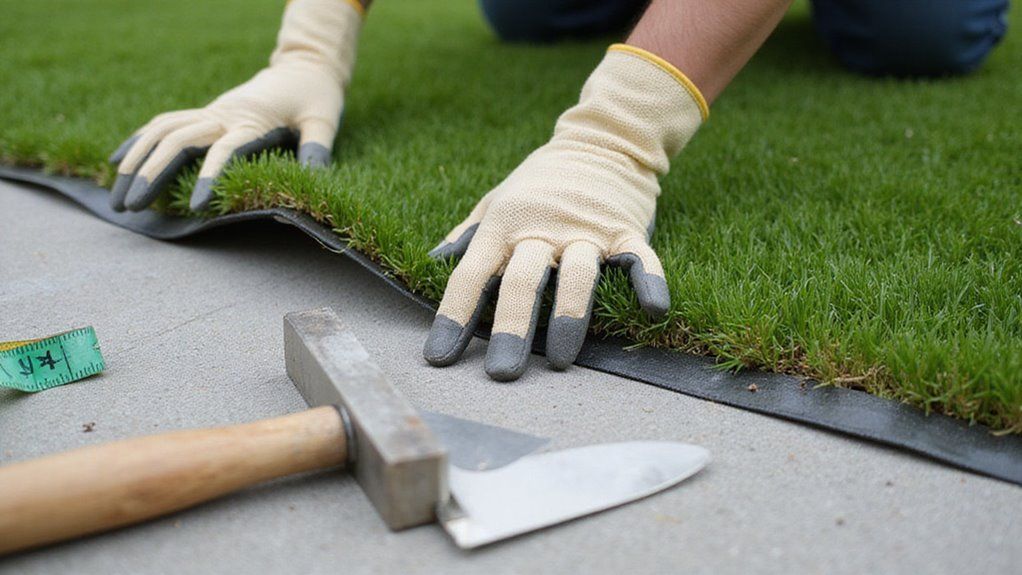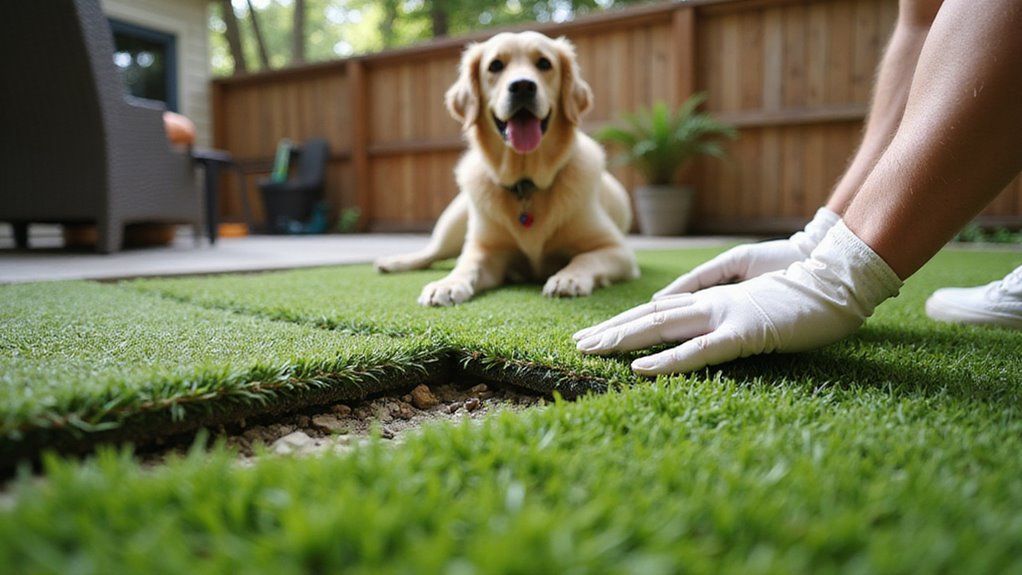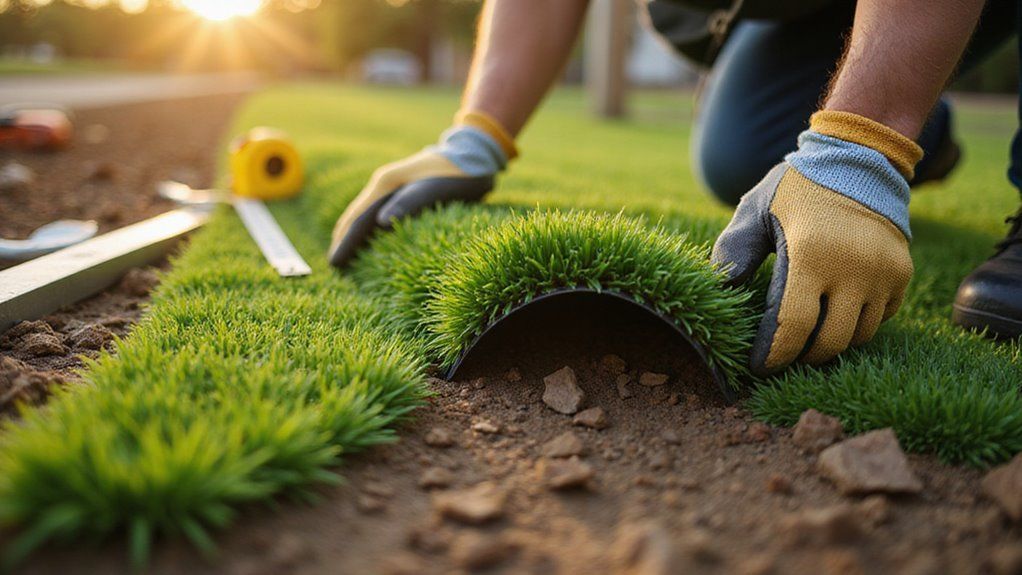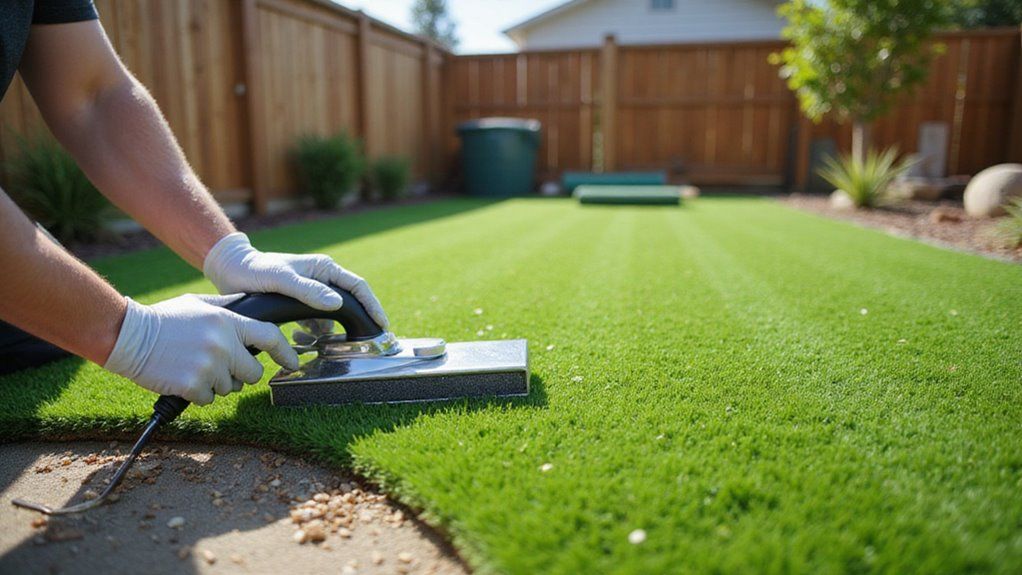How Hard Is It to Install Artificial Grass
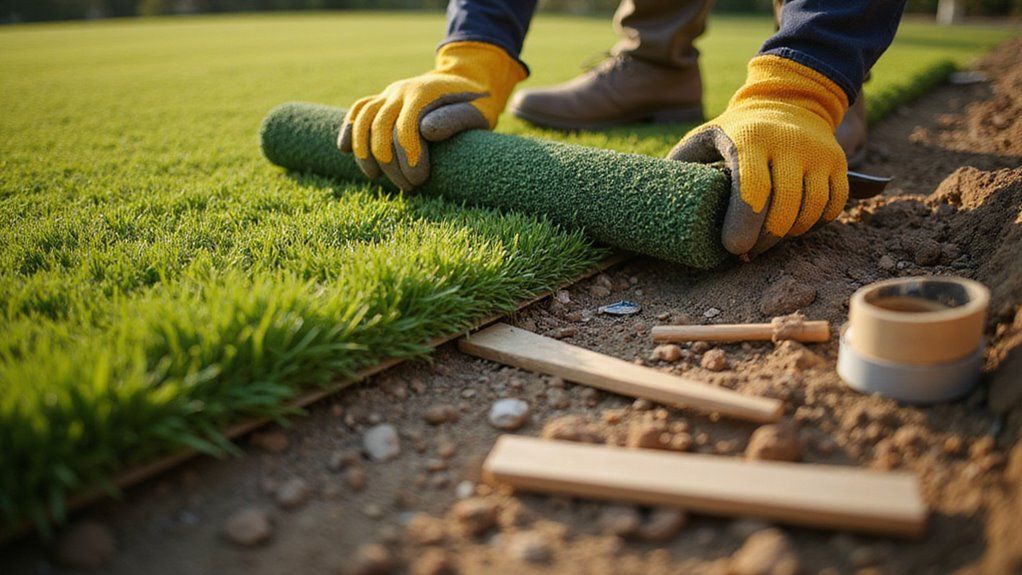
Beneath the perfect green facade lies a complex web of technical challenges and physical demands. Many homeowners dream of a maintenance-free lawn but lack the specialized skills for artificial grass installation. Without proper expertise, DIY attempts often lead to drainage issues, uneven surfaces, and costly repairs. Professional installation ensures lasting results but comes with significant expenses.
Installing artificial grass falls into the moderately difficult category of home improvement projects. The process requires specialized tools, technical knowledge of base preparation, and considerable physical effort. Most homeowners find the installation more challenging than initially expected.
This guide explores everything you need to know about installing artificial grass in your outdoor space.
Key Takeaways
- Artificial grass installation is physically demanding and requires specialized tools like plate compactors, seaming irons, and power brooms for proper results.
- Proper base preparation demands 4-6 inches of compacted material, complete vegetation removal, precise grading, and effective drainage system installation.
- Technical challenges include achieving invisible seams, uniform infill distribution, and accurate cutting around irregular spaces requiring significant skill and experience.
- DIY installation costs $2-8 per square foot but often requires $500-$2,000 in repairs within 2-3 years due to improper technique.
- Professional installation costs $8-18 per square foot but includes warranties, drainage compliance, and expertise that ensures long-lasting, maintenance-free results.
Is Installing Artificial Grass a DIY Project?

Artificial grass installation can be a DIY project, but it requires significant skill and effort. The job demands physical strength and expertise with specialized tools like compactors and carpet knives. A proper installation needs 4-6 inches of compacted base material plus precise measurements for drainage. Most homeowners find the technical aspects challenging, especially seaming and infill distribution.
Professional installation offers important benefits through warranties and code compliance. Local regulations require specific drainage standards that professionals understand. The extra cost of hiring experts often prevents expensive mistakes and future problems.
What Tools and Materials Do You Need?
You’ll need specialized equipment and materials to achieve a professional-grade artificial grass installation that meets Florida’s drainage requirements. Essential tools include plate compactors, power brooms, carpet knives with hooked blades, seaming irons, and drop spreaders for infill distribution.
Your material list must include quality synthetic turf, crushed aggregate base, decomposed granite or sand substrate, geotextile fabric, seaming tape, turf adhesive, and silica sand or rubber infill.
Basic Equipment Requirements
A complete artificial grass installation needs essential tools for proper setup. You must have shovels, rakes, and wheelbarrows for ground preparation. A plate compactor ensures proper base density and drainage. Sharp carpet knives help create clean turf edges.
Core tools include seaming tape, outdoor adhesive, and landscape pins for secure installation. Proper measuring equipment prevents wastage and ensures accurate cuts. The right drop spreader helps distribute infill material evenly across the surface.
Professionals recommend keeping spare blades and extra fastening materials on hand. Quality tools make the installation process smoother and more efficient.
Quality Artificial Turf Options
Top artificial turf options prioritize durability and weather resistance. Premium turf should have UV-stabilized blades made from polyethylene or polypropylene with a 10+ year lifespan. For residential use, select turf with 50-80 ounce face weight density.
Good drainage becomes essential in wet climates. The backing must include proper drainage holes to handle heavy rainfall. Additionally, antimicrobial treatments prevent mold growth in humid conditions.
Safety remains a key consideration for families. All materials should be certified lead-free and include appropriate infill like silica sand or rubber. These features ensure long-lasting performance and peace of mind.
Necessary Substrate Materials
The essential substrate materials for artificial lawn installation include crushed stone, geotextile fabric, and leveling sand. A 4-inch layer of crushed stone creates the foundation and enables proper drainage.
Geotextile fabric acts as a barrier against weeds while allowing water to flow through. A half-inch layer of leveling sand ensures an even surface for the turf.
Metal or plastic edge restraints secure the perimeter and prevent movement. These materials work together to create a stable, long-lasting base. Professional installation with quality materials leads to better performance and fewer future problems.
Tools for Proper Installation
Essential tools needed for artificial turf installation include basic and specialized equipment. A flat-nose shovel and wheelbarrow transport base materials across the worksite. A plate compactor stabilizes the ground and creates proper drainage. A carpet knife enables precise turf cutting for perfect fits.
Seaming tape, adhesive, and landscape stakes secure the installation properly. A drop spreader distributes infill material evenly at 2-3 pounds per square foot. A power broom grooms the surface to a professional finish. Protective tarps shield materials from unexpected weather.
How Difficult Is the Site Preparation Process?
Site preparation for artificial grass installation demands methodical execution across four critical phases that determine your turf’s longevity and performance.
You’ll need to systematically remove all organic material, establish precise grade levels, engineer adequate drainage systems, and compact a stable base layer before any synthetic material touches the ground.
Each phase presents distinct physical and technical challenges that directly impact your installation’s structural integrity and compliance with Florida’s drainage requirements.
Removing Existing Grass and Vegetation
Remove all grass, weeds, and organic material from the soil before installing artificial turf. A standard sod cutter will strip away existing vegetation to a depth of 2-4 inches. The sandy Florida soil makes this task easier. Spray persistent weeds with herbicide 1-2 weeks before removal.
Clear away rocks, roots, and plant debris completely from the bare soil surface. This thorough preparation prevents future dips or bumps. As a result, your new artificial lawn will have a stable, even foundation.
Finally, check the cleared area for any remaining vegetation or organic matter. A clean substrate ensures proper drainage and long-lasting results.
Ground Leveling Techniques
Basic tools help achieve level ground for installation. A laser level or 4-foot straight edge detects uneven spots. Most Florida yards need only 1-3 inches of base material adjustment due to sandy soil.
Proper leveling prevents future issues with artificial grass. Remove high spots with a shovel and add crushed stone to low areas. Each 2-inch layer requires compacting with a plate compactor.
Maintain a 1-2% slope away from structures for proper drainage. This slope protects against Florida’s heavy rains. Good drainage prevents water damage to nearby properties.
Proper Drainage Installation
Proper drainage requires three essential layers for successful artificial grass installation. A 2-4 inch crushed stone base creates the first critical foundation layer. The stone allows water to flow freely through the surface. A geotextile fabric barrier sits above the stone to block soil movement while enabling water drainage.
Perimeter channels direct excess water away from buildings and adjacent properties. Professional installers must compact the base to 90-95% density for optimal performance. Installation timing matters greatly during Florida’s wet seasons to ensure proper adhesive curing.
These drainage components prevent flooding, extend turf life, and protect property investments. Regular maintenance keeps the system working effectively year-round.
Base Material Application
A proper base material application requires crushed stone or decomposed granite as the foundation layer for artificial grass. The ideal base depth ranges from 3 to 4 inches for residential projects. The crushed stone creates essential drainage and prevents turf from sinking or shifting over time. Proper compaction provides stability for long-term performance.
A plate compactor helps achieve the necessary density levels. The base must maintain a 2% slope away from buildings to ensure effective water drainage. Laser levels assist in creating uniform thickness across the installation area. Moreover, quality base materials protect against settling and extend the lifespan of artificial grass installations.
How to Install Artificial Grass Properly
You’ll achieve a professional installation by following precise sequencing: accurate measurement and cutting, strategic positioning, mechanical edge securing, controlled infill distribution, and final grooming. Each step directly impacts drainage performance, seam integrity, and surface uniformity—errors compound quickly in Florida’s high-temperature conditions.
Proper technique at this stage determines whether your turf meets or exceeds the 10-year lifespan documented in Miami-Dade County installations.
Measuring and Cutting the Turf
Measure the turf area precisely and cut to fit your space. Take careful measurements of the installation area using a measuring tape. Allow rolled turf to relax flat for two hours before marking.
Cut synthetic grass from the backing side using sharp utility knives or carpet blades. Overlap seams by 1 inch and trim following the stitch lines for seamless joints. Make template cutouts from cardboard when fitting around obstacles or curves.
Moreover, check blade direction remains consistent across all pieces. This attention to detail ensures professional results and minimal waste. A proper fit prevents future lifting or separation issues.
Laying and Positioning Techniques
Position artificial turf with the grass blades facing your main viewing direction. This technique creates a uniform, natural appearance across the entire surface.
Each piece needs 2-3 inches of overlap at the edges for proper seaming. Cut both edges simultaneously with a sharp knife to ensure perfect alignment. Place seaming tape underneath and apply adhesive for a secure bond.
Secure the perimeter with 6-inch galvanized nails spaced 4-6 inches apart. Finally, inspect the surface for wrinkles or gaps before completing the installation. These careful positioning steps will deliver professional-quality results.
Securing Edges and Seams
Edges and seams require proper fastening to prevent turf movement and lifting. Professional installers use galvanized nails and landscape staples to secure artificial grass borders. Secure fasteners should be placed every 4-6 inches along all perimeter edges.
Quality seaming creates invisible connections between turf sections. Apply seaming tape underneath adjacent edges, then add adhesive evenly across the tape. Press sections together while matching the grass blade direction.
Furthermore, sealed edges protect against soil erosion and water damage. Careful installation prevents gaps, overlaps, and visible seam lines. Complete all seam work quickly in hot weather since adhesives cure faster above 85°F.
Adding Infill Material
To add infill material, spread sand or rubber across your artificial turf. Apply 1.5 to 3 pounds of silica sand or crumb rubber per square foot using a drop spreader. Brush the infill deeply into the turf fibers with a stiff broom.
The infill prevents grass blades from matting down and ensures proper drainage. A power broom works best to distribute materials evenly throughout the surface. Move the broom against the grain for thorough penetration.
Moreover, proper infill distribution creates stability and extends your turf’s lifespan. Check for consistent coverage across all areas before completing the installation.
Brushing and Final Touches
Proper brushing and final touches ensure a flawless artificial lawn installation. A thorough inspection must address three key areas. Check all seams carefully to spot gaps and loose spots in the adhesive.
Measure infill depth with a depth gauge to meet manufacturer requirements. Pour water across the surface to verify proper drainage patterns.
Concrete installations need extra attention at the edges. Secure perimeter anchoring must withstand normal foot traffic and weather conditions. Take detailed photos and notes about the completed work for future reference.
What Are the Common Installation Challenges?
You’ll encounter four primary installation challenges that can compromise your artificial grass system if not addressed properly. Irregular spaces and obstacles require precise cutting and seaming techniques, while Florida’s climate demands specific timing and weather adaptations.
Understanding these common issues—from managing complex layouts to correcting installation errors—will help you achieve a professional-grade result with proper drainage and surface integrity.
Dealing with Irregular Spaces
Irregular spaces require careful planning and precise cutting methods for proper artificial grass installation. Templates help map complex curves and angles before making any cuts. A paper or cardboard mockup prevents costly mistakes.
Essential tools include sharp utility knives, sturdy templates, and weather-rated seaming materials. Proper tools ensure clean cuts and durable seams in any shape. Furthermore, strategic seam placement keeps connections hidden from view.
Smart planning addresses key installation challenges around obstacles and borders. As a result, the finished lawn looks seamless across uneven areas. Professional measurements should allow 3–4 inches of excess material for trimming.
Working Around Obstacles and Features
Clear cutting patterns allow artificial grass installation around obstacles. Cut circular shapes for trees and posts using round templates. Create rectangular cuts for utility boxes with straight-edge guides.
Leave 2 to 3 inches of space around tree trunks to accommodate root growth. A careful approach prevents future damage and maintains professional results.
Strategic seaming techniques secure edges properly near obstacles. Proper infill distribution ensures safe walking surfaces and effective drainage. These methods create seamless transitions around landscape features.
Weather Considerations in Florida
Florida’s extreme climate affects synthetic turf installations significantly. Hot summers can damage materials and create unsafe working conditions. Unexpected storms bring delays and drainage concerns.
Installation works best during early morning hours between 65-80°F. Projects need 2-3 consecutive rain-free days for proper completion. The high humidity changes how adhesives cure and bond.
Smart weather planning leads to better results. Installers must check forecasts and prepare backup dates. Professional crews adapt their schedules around Florida’s weather patterns.
Fixing Installation Mistakes
Mistakes in artificial grass installation can be fixed with the right approach and tools. Major issues include wrinkles, seam separation, poor drainage, and uneven surfaces caused by improper base preparation. Lift affected turf sections to add or adjust base materials for proper leveling.
Professional help becomes necessary for complex repairs like seam failures and drainage problems. The repair process typically requires new adhesive, precise realignment techniques, and additional base material. Quick repairs prevent bigger issues from developing.
How Long Does the Installation Take?
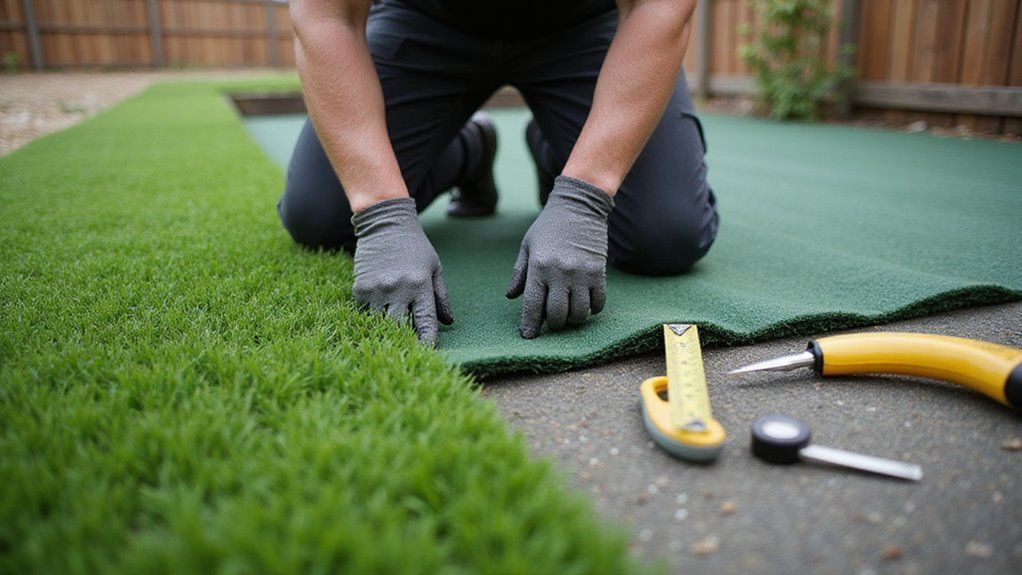
A standard artificial grass installation takes 2 to 5 days for most residential yards. The exact timeline depends on your yard size, ranging from 2 days for small areas to 5 days for large properties.
Several key factors affect the installation duration. Weather conditions can delay outdoor work significantly. Complex yard shapes require more careful cutting and seaming. Ground preparation complexity also impacts the schedule.
Professional installers complete projects faster than DIY attempts. However, with proper planning and attention to detail, homeowners can achieve quality results at their own pace. In addition, local climate patterns may extend or shorten the project timeline.
What’s the Cost Comparison: DIY vs Professional Installation?
You’ll face distinct financial trade-offs when choosing between DIY and professional artificial turf installation in Florida.
Material costs—including turf rolls, infill, base aggregate, geotextile fabric, seaming tape, and adhesives—remain constant regardless of installation method, but labor expenses and tool investments create significant price variations.
Your decision requires analyzing upfront equipment purchases against contractor fees, factoring in Florida-specific considerations like drainage systems and warranties that affect long-term value.
Material Costs Breakdown
A standard artificial grass installation costs $3.50-$17 per square foot for materials alone. The price varies based on material quality and project specifications.
Base materials like crushed stone and drainage aggregate run $0.50-$2.00 per square foot. Professional-grade synthetic grass comes in different price tiers. Economy turf costs $2-$6 per square foot, while premium options range from $8-$12.
Essential supplies add another layer of expense. Installation materials such as seaming tape, adhesive, and infill materials total $1-$3 per square foot. These components ensure proper drainage and long-term durability.
Labor Savings Analysis
DIY installation saves $5-$12 per square foot in labor costs compared to professional services. A typical 500-square-foot lawn project costs $2,500-$6,000 for professional installation labor. DIY installation requires 20-40 hours of work. Professional teams complete the same project in 1-3 days.
However, homeowners must consider equipment rental fees and physical demands. Rental equipment costs range from $200-$400. Professionals provide warranties and ensure proper drainage compliance. Their expertise prevents costly mistakes and maintains local code requirements.
Professionals handle critical tasks like substrate layering and drainage installation. This expertise becomes especially valuable in areas with strict regulations.
Tools Investment Considerations
Strategic tool investment choices will impact your artificial turf installation costs and quality. Basic DIY turf tools cost $500-1000 upfront, while weekly equipment rentals range from $200-400. Quality tools ensure proper installation and prevent costly mistakes. Professional-grade equipment delivers better results for long-term satisfaction.
To maximize your investment, consider project timeline and frequency of use. Professionals spread equipment costs across multiple jobs. For single installations, renting specialized tools like power brooms and seam cutters proves more cost-effective.
Long-term Value Assessment
Professional installation offers better long-term value despite higher initial costs. Initial DIY costs range from $2-8 per square foot, while professional rates run $8-18 per square foot. Most DIY installations need repairs within 2-3 years, adding $500-2,000 to total costs. Professional installations include valuable warranties for seams, infill, and drainage problems.
Moreover, certified installers properly address slope and drainage concerns in Florida’s climate. Their expertise prevents potential legal issues with neighboring properties. Professional work must comply with Florida Statutes Chapter 604 regarding water runoff management.
Ready for a Lush, Maintenance-Free Lawn? Contact Synthetic Turf Treasure Coast Today!
Professional installation protects your investment in a beautiful, maintenance-free lawn. Expert installers ensure proper drainage, prevent surface issues, and guarantee long-lasting results. Local code compliance requires specific drainage systems and substrate preparation standards in Florida.
A certified team handles critical details like surface leveling, seam connections, and infill distribution correctly. Their expertise prevents common problems such as pooling water or uneven spots. Moreover, professional installation includes manufacturer warranties for peace of mind.
Choose qualified specialists to create an attractive, sustainable landscape that adds value to your property. The results will delight both you and your neighbors for years to come.
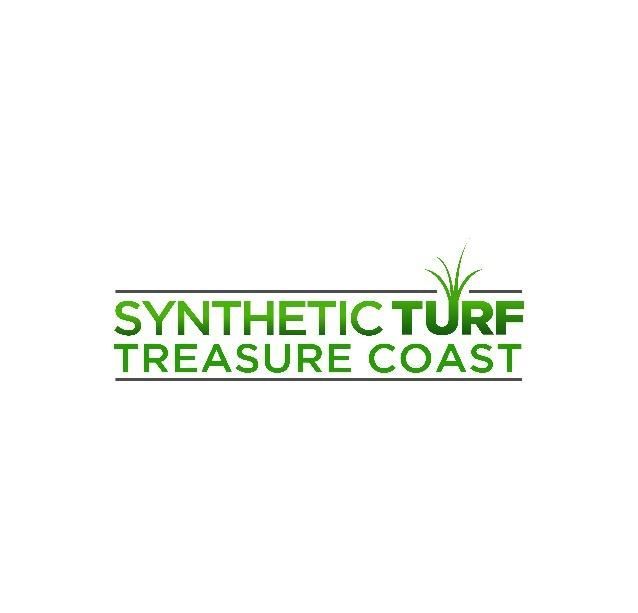
About the author
Kathy Leavell
Kathy Leavell is the founder and owner of Synthetic Turf Treasure Coast, a leading provider of synthetic grass solutions for residential and commercial properties in Florida. With over a decade of experience in the industry, Kathy has become a recognized expert in synthetic turf installation, maintenance, and repair. Under her leadership, Synthetic Turf Treasure Coast has earned a reputation for exceptional customer service and high-quality workmanship.
Prior to starting her own business, Kathy worked in sales and marketing roles at several major synthetic turf manufacturers.
